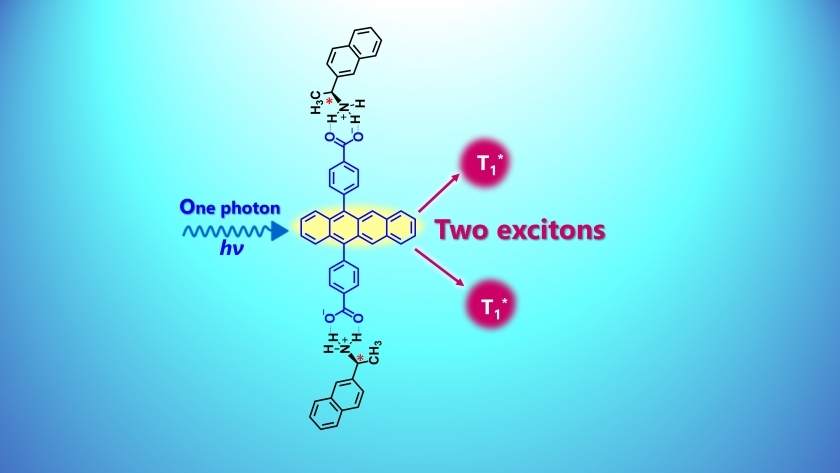We reach more than 65,000 registered users in Dec!! Register Now

Improving energy production by boosting singlet fission process
- December 22, 2024
- 3 Views
- 0 Likes
- 0 Comment
Singlet fission can be promoted by chiral molecular self-assemblies that absorb light
In organic molecules an exciton is a particle bound pair of an electron (negative charge) and its hole (positive charge). They are held together by Coulombic attraction and can move within molecular assemblies. Singlet fission (SF) is a process where an exciton is amplified, and two triplet excitons are generated from a singlet exciton. This is caused by the absorption of a single particle of light, or photon, in molecules called chromophores (molecules that absorb specific wavelengths of light). Controlling the molecular orientation and arrangement of chromophores is crucial for achieving high SF efficiency in materials with strong potential for optical device applications.
So far, studies on SF have been conducted in solid samples, but there is yet to be comprehensive design guidelines for the molecular organization required for efficient SF.
Professor Nobuo Kimizuka and his colleagues from Kyushu University have now successfully demonstrated that SF can be promoted by introducing chirality (molecules that cannot be superimposed on their mirror images) into chromophores and achieving chiral molecular orientation in self-assembled molecular structures. Publishing in Advanced Science, the team showed SF-based triplet excitons in self-assembled aqueous nanoparticles containing chiral π-electron chromophores, a phenomenon not observed in similar racemic nanoparticles (a mixture of equal amounts of molecules that are mirror images of each other).
Kimizuka says, “We have discovered a novel method to enhance SF by achieving chiral molecular orientation of chromophores in self-assembled structures.”
The researchers investigated the SF characteristics of aqueous nanoparticles, which self-assembled from ion pairs of tetracene dicarboxylic acid and various chiral or non-chiral amines. They identified the critical role of the counterion (an ion with a charge opposite to that of another ion in the solution), specifically the ammonium molecule. The counterion influenced the molecular orientation of the ion pairs, the structural regularity, the spectroscopic properties, and the strength of the intermolecular coupling between tetracene chromophores. Thus, the counterion played a key role in controlling the alignment of the chromophores and the associated SF process.
Through extensive experimentation with chiral amines, the team achieved a triplet quantum yield of 133% and a rate constant of 6.99 × 109 s−1. In contrast, they observed that nanoparticles with achiral counterions did not exhibit SF.
The racemic ion pair also produced an intermediate correlated triplet pair state by SF. However, triplet-triplet annihilation was dominant in the triplet pairs; therefore, no dissociation into free triplets was observed.
“Our research offers a novel framework for molecular design in SF research and will pave the way for applications in energy science, quantum materials, photocatalysis, and life science involving electron spins. Furthermore, it inspires us to continue exploring SF in chiral molecular assemblies in organic media and thin film systems, which are critical for applications in solar cells and photocatalysts,” concludes a hopeful Kimizuka.
List of Referenes
- Ilias Papadopoulos, Joseph Ka‐Ho Hui, Masa‐aki Morikawa, Yasuhito Kawahara, Kenji Kaneko, Kiyoshi Miyata, Ken Onda, Nobuo Kimizuka. Chirality in Singlet Fission: Controlling Singlet Fission in Aqueous Nanoparticles of Tetracenedicarboxylic Acid Ion Pairs. Advanced Science, 2024; 11 (39) DOI: 10.1002/advs.202405864
Cite This Article as
No tags found for this post









